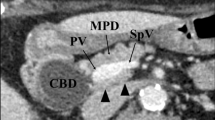Abstract
Background
Duodenum-preserving pancreatic head resection (DPPHR) serves as a surgical intervention for managing benign and low-grade malignant neoplasms located in the head of the pancreas. This surgical approach enables the thorough excision of pancreatic head lesions, reducing the necessity for digestive tract reconstruction and enhancing the patient’s quality of life.1 Performing a minimally invasive DPPHR is a complex surgical procedure, particularly when safeguarding the bile duct and the pancreaticoduodenal arterial arch. Robotic surgery is among the latest innovations in minimally invasive surgery and is widely used in many surgical specialties. It offers advantages such as rotatable surgical instruments, muscle tremor filters and up to 10–15 times three dimensional (3D) visual field,2 and achieves high flexibility and accuracy in surgical operations. Indocyanine green (ICG) fluorescence imaging technology is also applied to provide real-time intraoperative assessment of the biliary system and blood supply, which helps maintain the biliary system’s integrity.3,4 We first report the complete procedure of ICG applied to the da Vinci robotic Xi system for preserving the DPPHR.
Methods
A 48-year-old female patient was diagnosed with pancreatic duct stones, chronic pancreatitis, and pancreatogenic diabetes. Enhanced computed tomography (CT) scans revealed pancreatic head stones, pancreatic atrophy, scattered calcifications, and a dilated pancreatic duct. An attempt at endoscopic retrograde cholangiopancreatography (ERCP) treatment was abandoned during hospitalization due to unsuccessful catheterization. Following informed consent from the patient and her family, a robotic DPPHR was conducted utilizing ICG fluorescence imaging technology. Approximately 60 min before the surgery, 2 mg of ICG was injected via the peripheral vein. The individual was positioned in a reclined posture with the upper part of the bed raised to an angle of 30° and a leftward tilt of 15°. Upon entering the abdominal cavity, existing adhesions were meticulously separated and the gastrocolic ligament was opened to expose the pancreas. The lower part of the pancreas was separated and the superior mesenteric vein (SMV) was identified at the inferior boundary of the pancreatic neck. The pancreas was cut upward and the pancreatic duct was severed using scissors. Dissection of the lateral wall of the portal vein-SMV in the pancreatic head segment was performed. Meticulous dissection was carried out along the pancreatic tissue, retracting the uncinate process of the pancreas in an upward and rightward direction. During the dissection, caution was exercised to protect the anterior and posterior pancreaticoduodenal arterial arch. By using ICG fluorescence imaging, the path of the common bile duct was identified and verified. Caution was exercised to avoid injuring the bile duct. After isolating the CBD, the head and uncinate process of the pancreas was entirely excised. Under the fluorescence imaging mode, the wholeness of the CBD was scrutinized for any potential seepage of the contrast agent. Ultimately, a Roux-en-Y end-to-side pancreaticojejunostomy (duct to mucosa) was executed.
Results
The surgery took 265 min and the estimated blood loss was about 150 mL. Without any postoperative complications, the patient was released from the hospital 13 days following the surgery. Postoperative pathology confirmed pancreatic duct stones and chronic pancreatitis. We have successfully performed four cases of robotic DPPHR using this technique, with only one patient experiencing a postoperative complication of pulmonary embolism. All patients were discharged successfully without any further complications.
Conclusions
Employing ICG fluorescence imaging in a robotic DPPHR has been demonstrated to be both secure and achievable. This technique potentially provides novel therapeutic perspectives, particularly for patients with ambiguous delineation between pancreatic and biliary ductal structures.
Similar content being viewed by others
References
Beger HG, Schlosser W, Friess HM, Büchler MW. Duodenum-preserving head resection in chronic pancreatitis changes the natural course of the disease: a single-center 26-year experience. Ann Surg. 1999;230:512–9.
De Pastena M, Esposito A, Salvia R. The role of the robot-assisted procedure during total pancreatectomy: a viewpoint. Hepatobiliary Surg Nutr. 2021;10:405–6.
Chen S, Gao P, Cai H, et al. Indocyanine green-enhanced fluorescence in laparoscopic duodenum-preserving pancreatic head resection: technique with video. Ann Surg Oncol. 2020;27:3926–7.
Zhang Y, Zhang J, Jiang K, Wu W. Indocyanine green real-time-guided laparoscopic duodenum-preserving pancreatic head resection. J Minim Access Surg. 2022;18:632–4.
Acknowledgment
The authors gratefully acknowledge The First Affiliated Hospital of Chongqing Medical University for the clinical data support.
Funding
The Natural Science Foundation of Chongqing (CSTB2023NSCQ- BHX0131) and the Postdoctoral Cultivation Project of the First Affiliated Hospital of Chongqing Medical University (CYYY-BSHPYXM-202315).
Author information
Authors and Affiliations
Contributions
YL and YL wrote the study. KZ, ML, and ZW chose and edited the video. BZ provided the final endorsement for the published version.
Corresponding author
Ethics declarations
Disclosures
Yan Li, Kezhen Zong, Ming Li, Yanyao Liu, Zhongjun Wu, and Baoyong Zhou have no potential conflicts of interest to declare.
Informed Consent
Permission was granted by the patient for the release of this report and any related images for publication.
Additional information
Publisher's Note
Springer Nature remains neutral with regard to jurisdictional claims in published maps and institutional affiliations.
Supplementary Information
Below is the link to the electronic supplementary material.
Supplementary file1 (MP4 269905 kb)
Rights and permissions
Springer Nature or its licensor (e.g. a society or other partner) holds exclusive rights to this article under a publishing agreement with the author(s) or other rightsholder(s); author self-archiving of the accepted manuscript version of this article is solely governed by the terms of such publishing agreement and applicable law.
About this article
Cite this article
Li, Y., Zong, K., Li, M. et al. Video-Based Indocyanine Green Fluorescence Applied to Robotic Duodenum-Preserving Pancreatic Head Resection. Ann Surg Oncol 31, 2654–2655 (2024). https://doi.org/10.1245/s10434-024-14911-y
Received:
Accepted:
Published:
Issue Date:
DOI: https://doi.org/10.1245/s10434-024-14911-y




